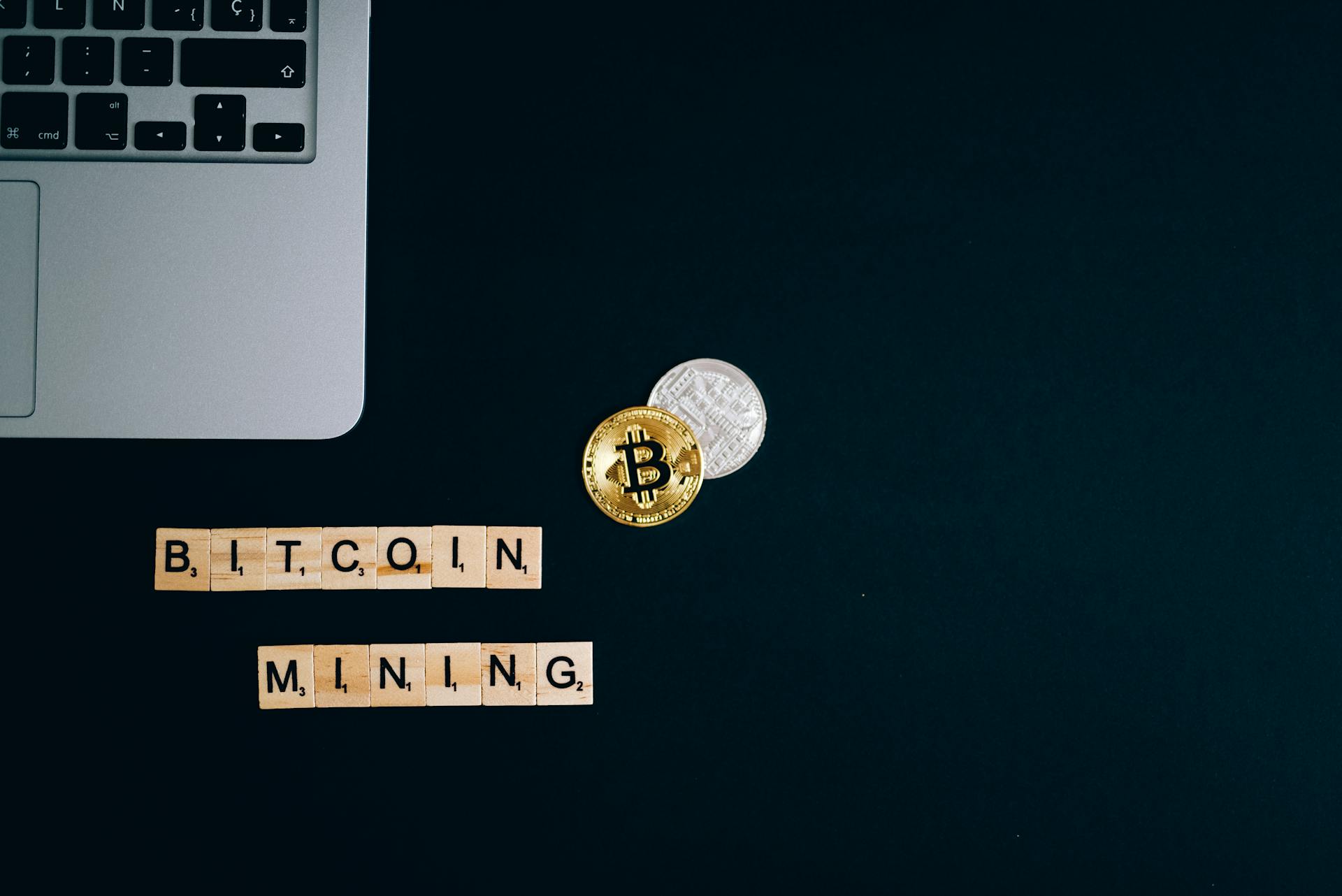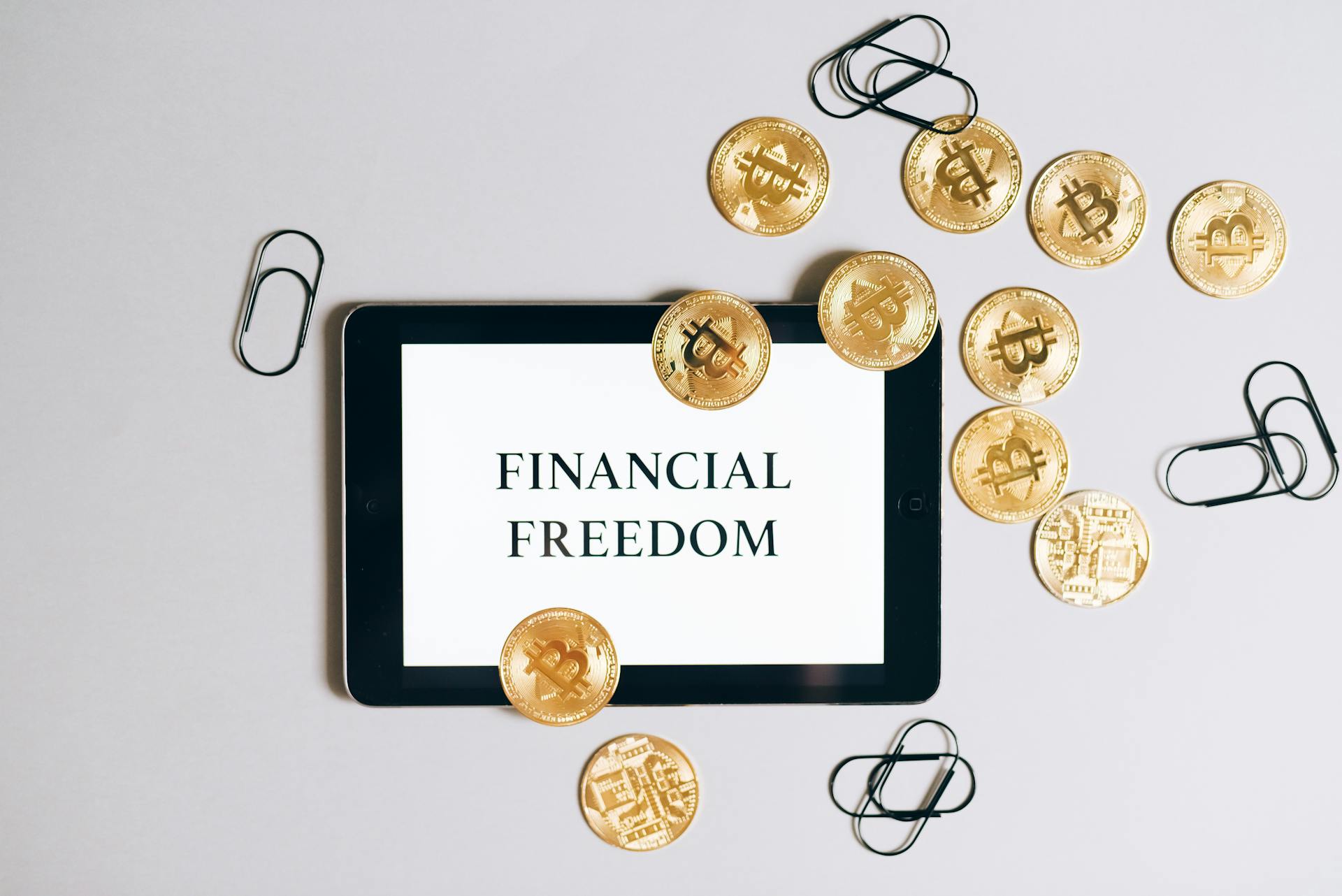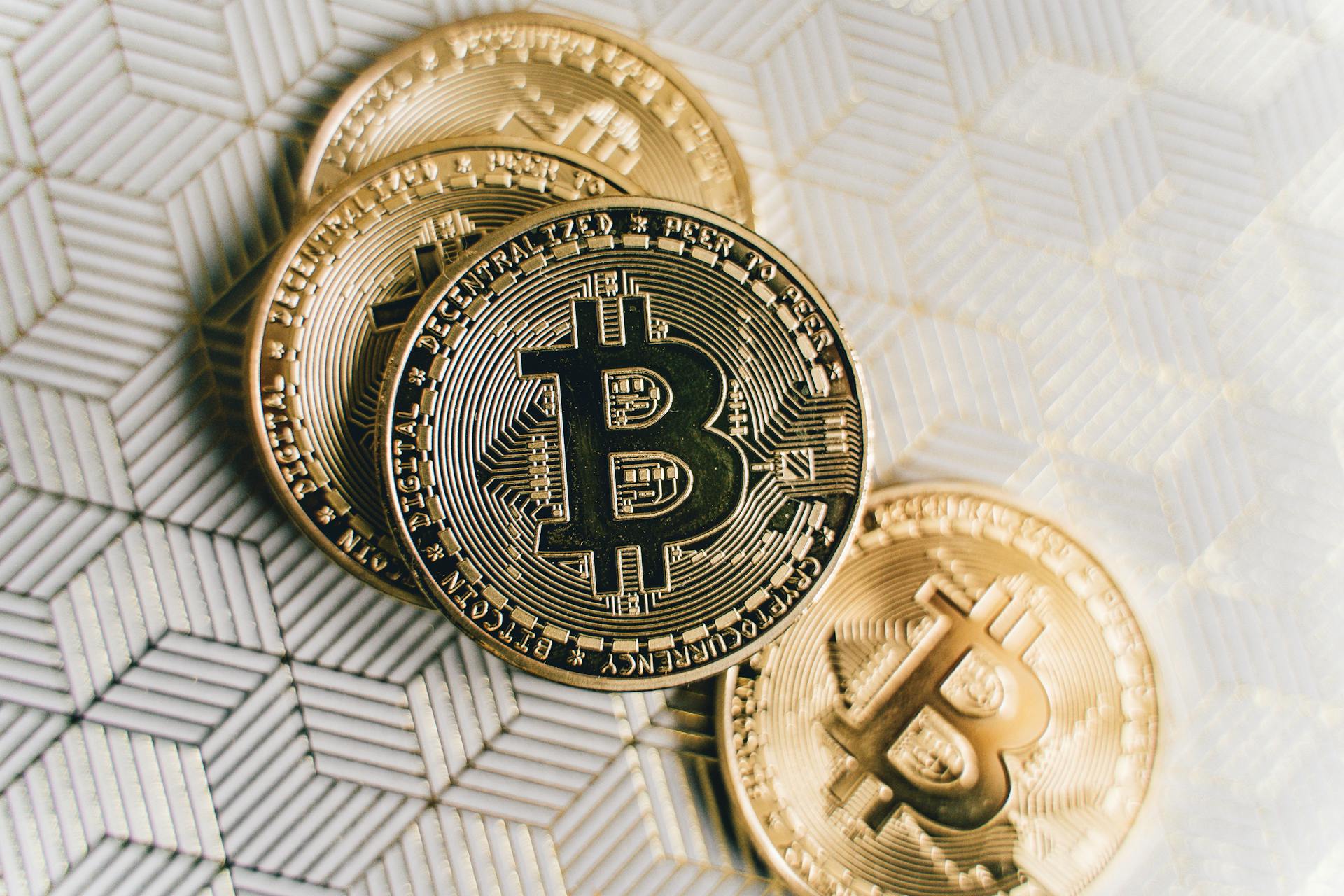
Investing in Bitcoin can be intimidating, especially for beginners. You need to understand the basics before diving in.
First, let's talk about what Bitcoin is - a digital currency that allows for peer-to-peer transactions without the need for intermediaries. It was created in 2009 by an individual or group using the pseudonym Satoshi Nakamoto.
To start investing in Bitcoin, you'll need to set up a digital wallet, which can be done through online platforms or mobile apps. These wallets allow you to store, send, and receive Bitcoins securely.
It's essential to understand that Bitcoin is a highly volatile asset, with its value fluctuating rapidly. This means that the price can drop significantly in a short period, so it's crucial to do your research and set a budget before investing.
What Is It and How Does It Work?
Bitcoin is a cryptocurrency that operates outside the control of any one person, group, or entity, eliminating the need for trusted third-party involvement in financial transactions.
It's designed to act as money and a form of payment, which has become its most defining characteristic.
Bitcoin was introduced to the public in 2008 by an anonymous developer or group of developers using the name Satoshi Nakamoto.
The anonymity of its creator has contributed to its mystique and intrigue.
Bitcoin has since become the most well-known and largest cryptocurrency in the world, inspiring the development of many other cryptocurrencies.
Its popularity has led to a vast and diverse community of users, investors, and developers.
Bitcoin's decentralized nature means that transactions are recorded on a public ledger called a blockchain, which is maintained by a network of computers around the world.
This makes it a secure and transparent form of payment.
Investing in Bitcoin
Investing in Bitcoin can be done through various methods, including buying Bitcoin itself on a crypto exchange like Binance.US, Coinbase, or Kraken. You can also use online stockbrokers like Fidelity and E-Trade, or trading apps like Robinhood.
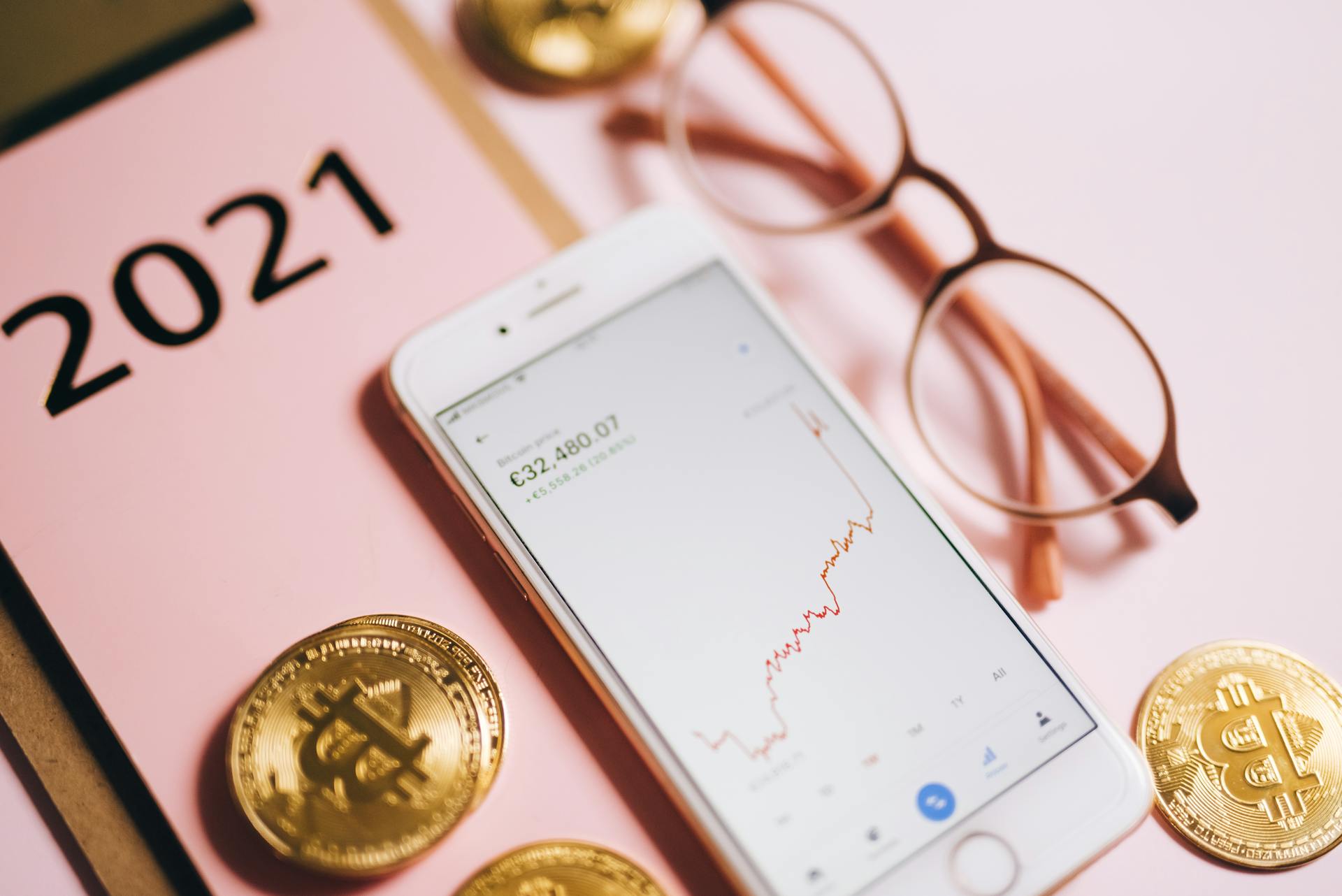
To buy Bitcoin, you'll need to create a "crypto wallet" to hold your fractional shares of the cryptocurrency. The smallest share of each bitcoin is called a Satoshi, equal to a hundred millionth of one bitcoin. You can start investing with as little as $1 on Coinbase, although with a 50-cent fee, you'd only get about 50 cents in Bitcoin.
Some other options for investing in Bitcoin include exchange-traded funds (ETFs) from investment firms like Blackrock and Fidelity. These ETFs can make Bitcoin easier to buy and sell, and they have better regulations. However, if you buy directly from the exchange, you have direct ownership of your coins and aren't restricted to trading on traditional stock exchanges.
Here are the 6 common ways to invest in Bitcoin:
- Bitcoin wallets and centralized cryptocurrency exchanges
- Certain traditional brokers
- Money transfer apps
- Bitcoin ATMs
- Bitcoin ETFs
- Buying Bitcoin itself
When investing in Bitcoin, it's essential to consider it within your entire investment strategy. Most finance experts recommend a diverse portfolio, with cryptocurrencies not accounting for more than 3% of your investments.
Investing Basics
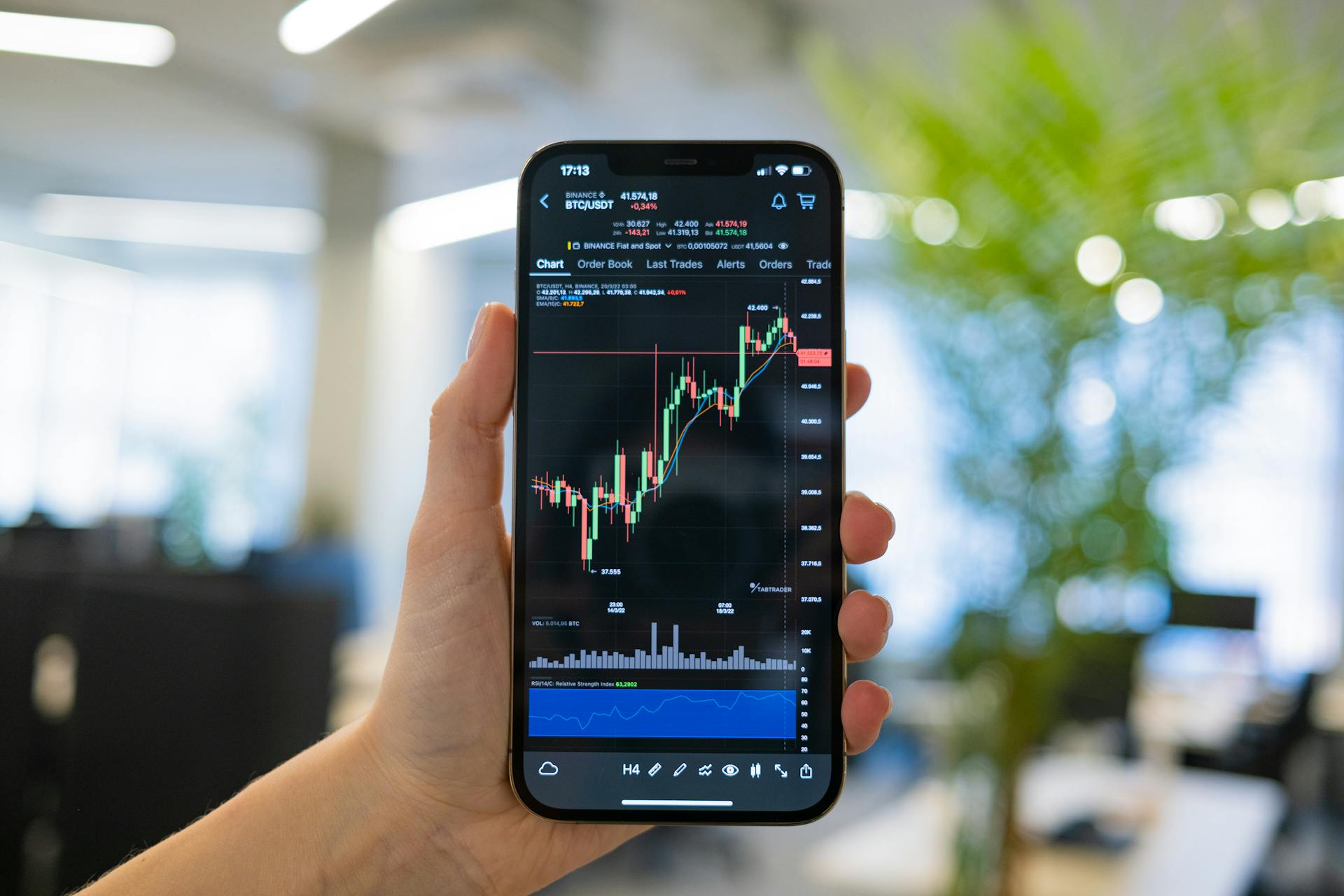
Investing in Bitcoin can seem intimidating, but it's actually quite accessible. You can buy Bitcoin itself on a crypto exchange like Binance.US, Coinbase, or Kraken, and create a "crypto wallet" to hold your fraction of the cryptocurrency.
The smallest share of each bitcoin is called a Satoshi, equal to a hundred millionth of one bitcoin. The smallest investment you can make on Coinbase is $1, but with a 50-cent fee, you would only get about 50 cents in Bitcoin.
You can also invest in Bitcoin through online stockbrokers like Fidelity and E-Trade, or trading apps like Robinhood. These platforms let you buy a fraction of Bitcoin and other cryptocurrencies for as little as $1.
Investing in a fund can make Bitcoin easier to buy and sell, and it also has better regulations. However, buying directly from the exchange gives you direct ownership of your coins and isn't restricted to trading on traditional stock exchanges.
Here's an interesting read: Coinbase Etfs
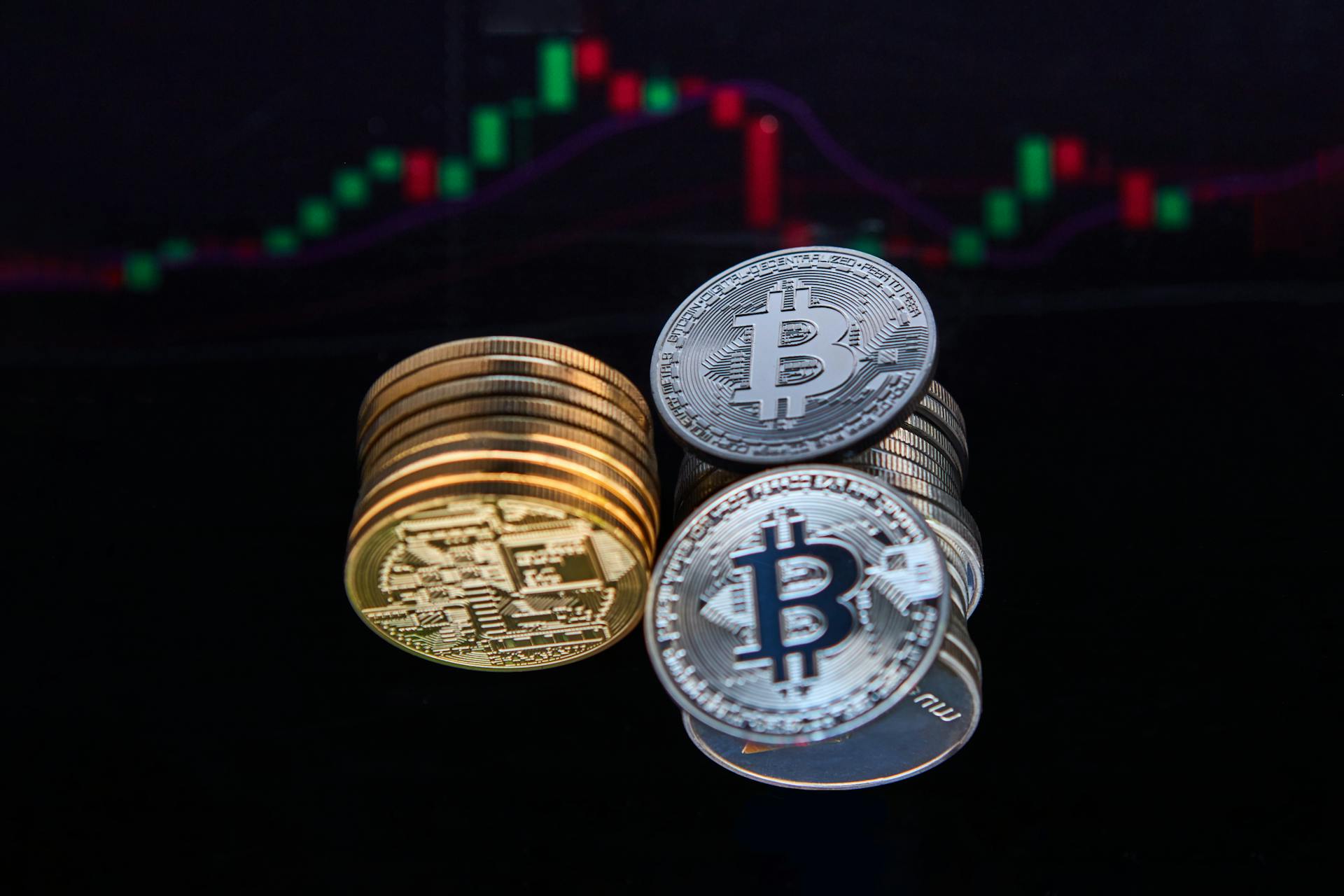
To invest in Bitcoin, consider it within your entire investment strategy. Most finance experts recommend a diverse portfolio, with cryptocurrencies not accounting for more than 3% of your investments.
Here are some ways to invest in Bitcoin:
- Buying Bitcoin itself on a crypto exchange
- Investing through online stockbrokers or trading apps
- Investing in a fund, such as a Bitcoin ETF
- Using a Bitcoin ATM (but be aware that these often come with high fees)
- Trading on a centralized cryptocurrency exchange
Remember, it's always a good idea to do your research and consider your own risk tolerance before investing in Bitcoin.
Investing and Speculating
Investing in Bitcoin can be a wild ride, but it's also a great way to diversify your portfolio and potentially earn some serious returns. Bitcoin prices tend to follow stock market trends, but they can also be greatly exaggerated, with movements of thousands of dollars happening in a short amount of time.
To invest in Bitcoin, you can buy it directly on a crypto exchange like Binance.US, Coinbase, or Kraken. This will give you direct ownership of your coins, but it also means you'll be responsible for storing them safely. The smallest investment you can make on Coinbase is $1, and with a 50-cent fee, you'll only get about 50 cents in Bitcoin.

You can also invest in Bitcoin through online stockbrokers like Fidelity and E-Trade, or trading apps like Robinhood. These platforms allow you to invest in Bitcoin and other cryptocurrencies, and some of them even let you buy fractions of Bitcoin for as little as $1.
Another way to invest in Bitcoin is through exchange-traded funds (ETFs), which are approved by the SEC and offer a more regulated way to invest in crypto. ETFs are similar to how you buy stocks, and you can invest as little or as much as you'd like.
If you're new to investing in Bitcoin, it's a good idea to start with a small amount and gradually increase your investment over time. This is known as dollar-cost averaging, and it can help you smooth out the ups and downs of the market. The theory behind it is that the cost will average out over time, so you'll end up getting Bitcoin at the best price point.
Here are some common ways to invest in Bitcoin:
- Buy Bitcoin directly on a crypto exchange
- Invest through online stockbrokers or trading apps
- Use exchange-traded funds (ETFs)
- Try dollar-cost averaging to smooth out market fluctuations
Remember, investing in Bitcoin is a high-risk, high-reward proposition, and it's essential to carefully consider whether it's the right investment for you.
Worth a look: Why Are Bitcoins so High
Rewards
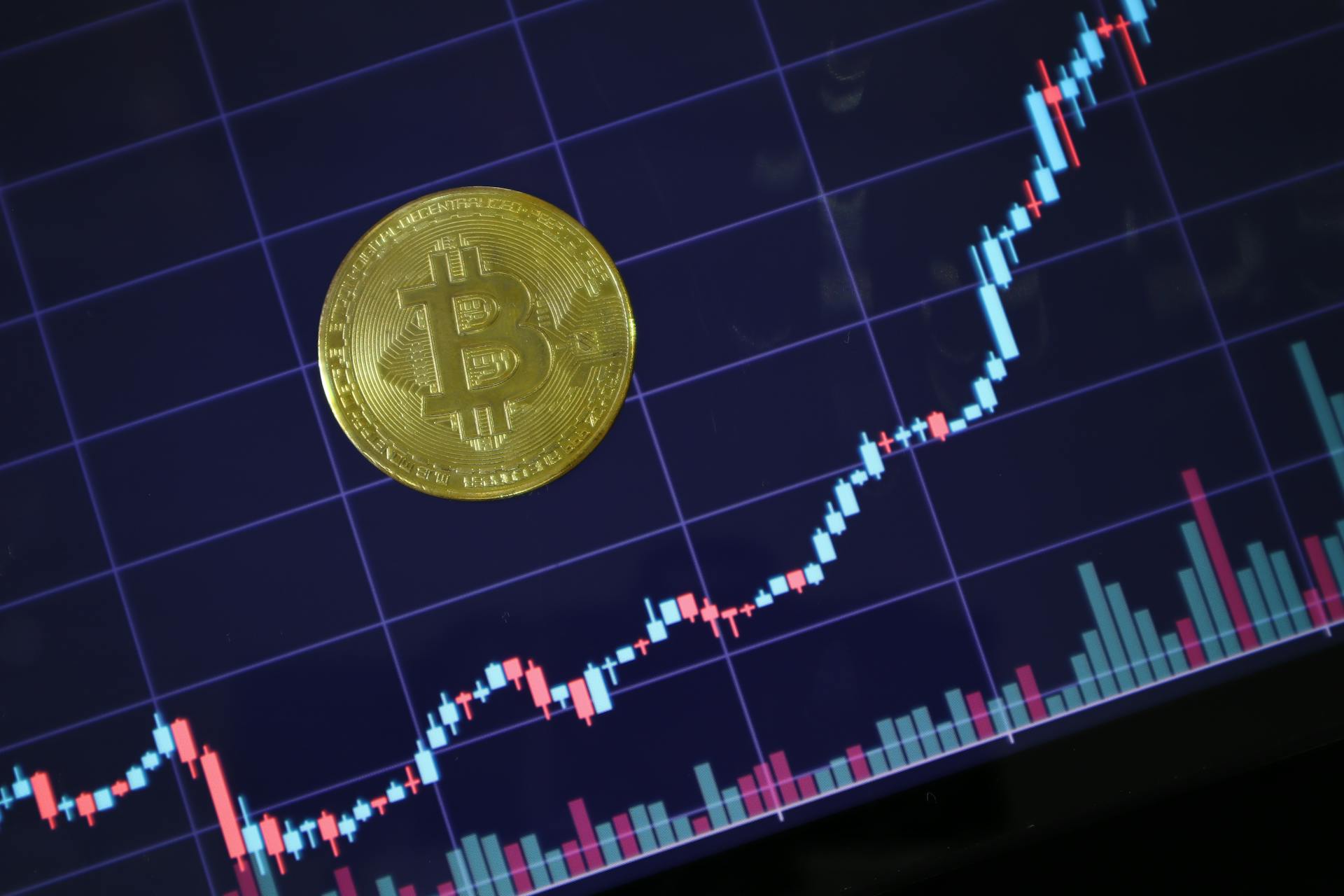
Bitcoin's rewards system is a crucial aspect to understand as an investor. Rewards are halved every 210,000 blocks.
The first halving occurred in 2009, with a block reward of 50 new bitcoins. This halving process has a significant impact on the supply of new bitcoins entering the market.
The third halving occurred on May 11, 2020, reducing the block reward to 6.25 bitcoins. This decrease in rewards has been a deliberate design choice to control the supply of new bitcoins.
The fourth halving took place in April 2024, lowering the reward to 3.125 bitcoins. This reduction is a result of the predetermined schedule of halvings.
The next halving is expected to occur in mid-2028, bringing the reward down to 1.5625 BTC.
Explore further: Bitcoin Halving
Bitcoin Technology
Bitcoin Technology is built on a decentralized network of computers, allowing for peer-to-peer transactions without the need for intermediaries.
This decentralized system uses a consensus mechanism called Proof of Work (PoW), which requires powerful computers to solve complex mathematical equations to validate transactions and create new Bitcoins.
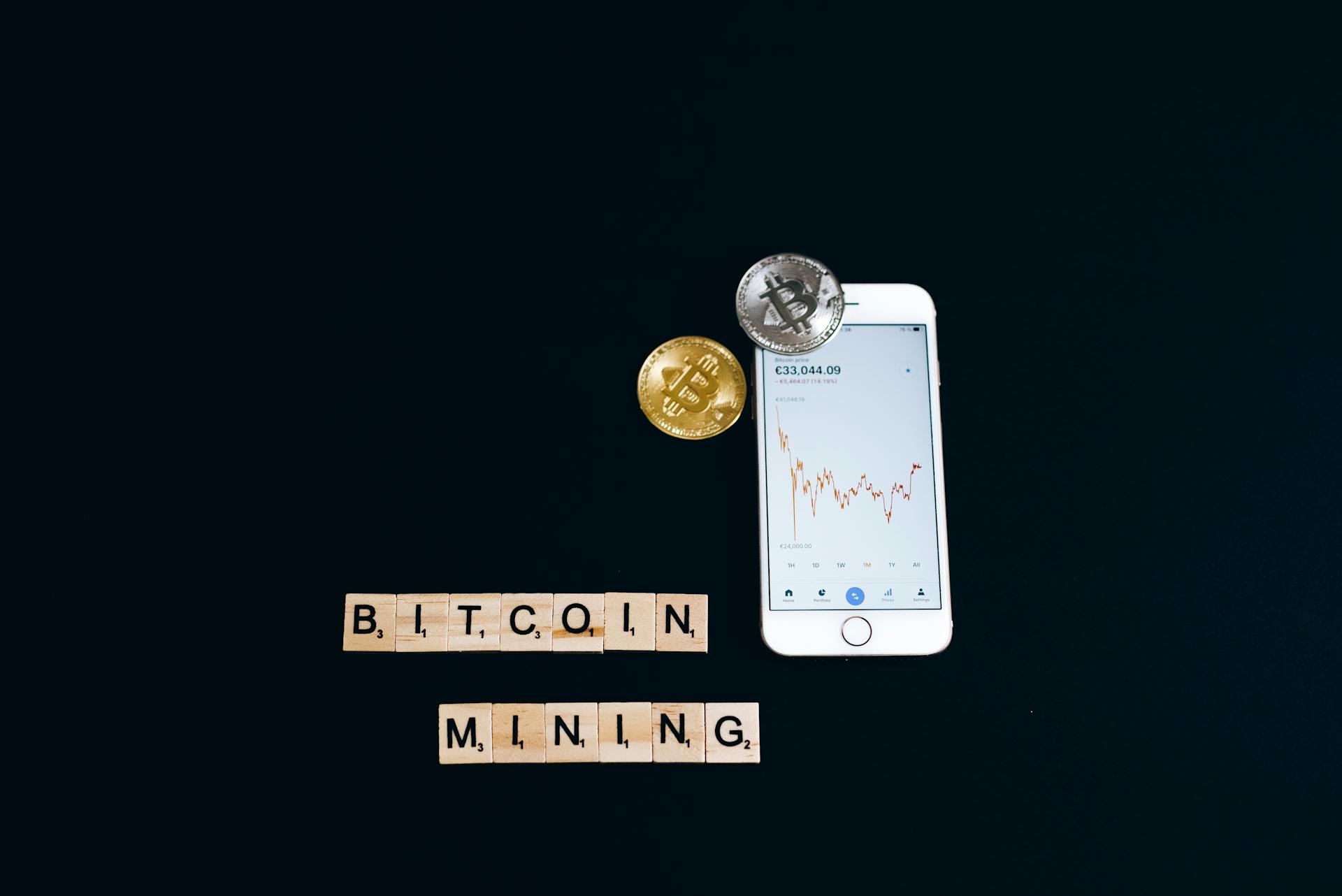
Each Bitcoin transaction is recorded on a public ledger called the blockchain, which is maintained by a network of computers worldwide.
The blockchain is a secure and transparent way to record transactions, making it difficult for hackers to alter or manipulate the data.
Bitcoin's decentralized nature and cryptographic security features make it a highly secure investment option.
You might enjoy: How Secure Are Bitcoins
Blockchain Technology
Blockchain technology is the backbone of Bitcoin, and it's a game-changer. A blockchain is a distributed ledger, a shared database of information that's stored on many computers, not just one central server.
This decentralized approach makes it virtually impossible for a single entity to manipulate the data. A network of automated programs, known as miners, maintain the blockchain and perform the necessary functions to keep it running.
Each block on the blockchain contains a block header, transaction counter, and the transactions recorded in the block. The block header is made up of several key elements.
Related reading: What Is Bitcoins Blockchain
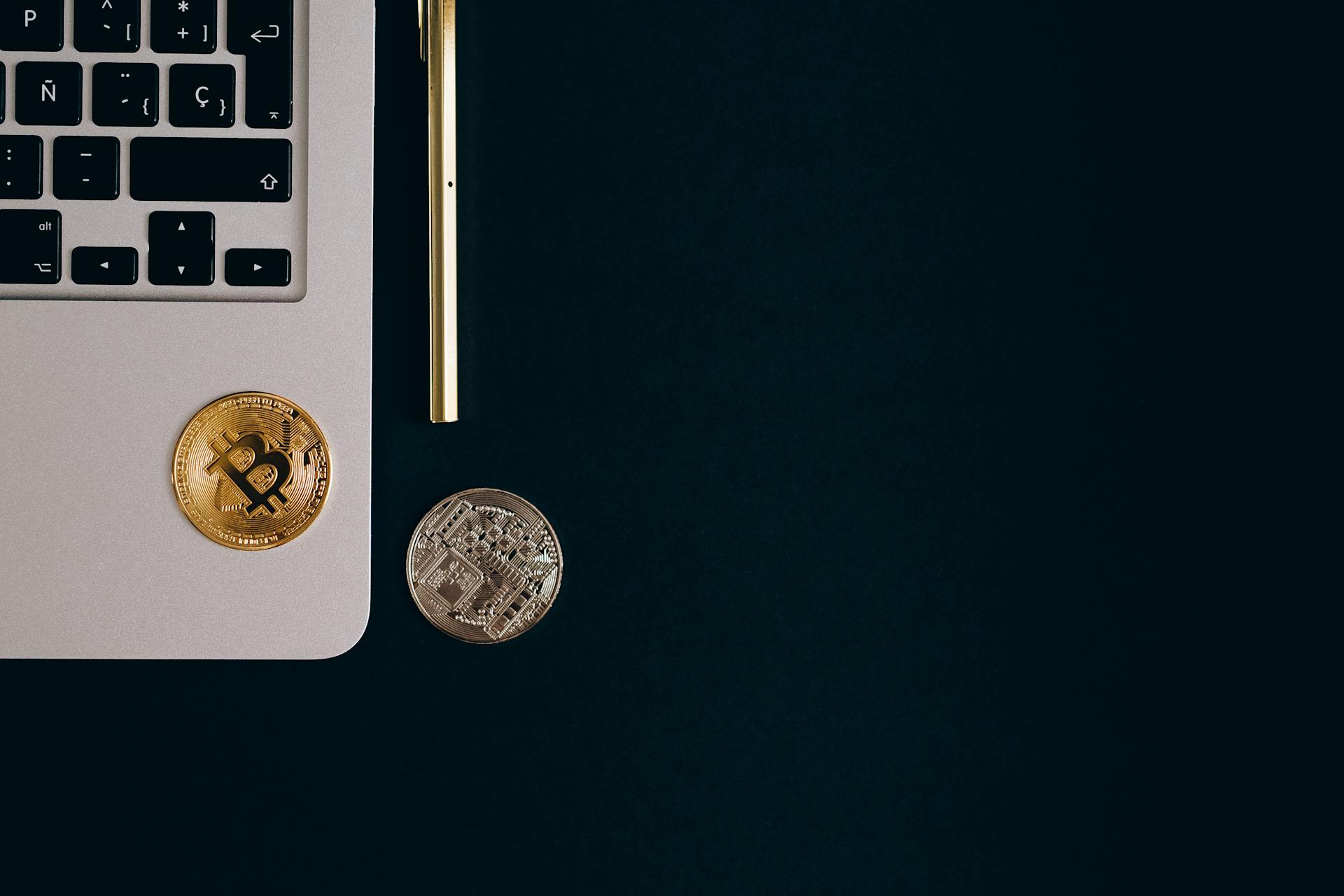
Here are the key elements of the block header:
- Software version: The version of the blockchain being run
- Previous block hash: The encrypted information from the previous block
- Merkle root: A single hash that contains all the hashed information from previous transactions
- Timestamp: The date and time the block was opened
- Difficulty target: The current network difficulty problem miners are attempting to solve
- Nonce: A short code used to solve the mining problem and open the block
As each block is added to the blockchain, it creates a chain of encrypted blocks that contain information from all previous blocks, going back to the first block.
Encryption
Bitcoin uses the SHA-256 hashing algorithm to encrypt transaction data stored in blocks on the blockchain.
This encryption process creates a 256-bit (64-digit) hexadecimal number that contains all transaction data and information linked to the blocks before that block.
The hash is used in the next block, then its hash is used in the next, and so on, but all blocks can be read.
The encryption ensures that blocks cannot be changed without changing all other blocks, making the blockchain a secure and auditable record of transactions.
Mining and Options
You can use your existing computer and mining software to join a mining pool, combining your computational power with others to compete with large ASIC mining farms.
Some popular mining programs include CGMiner and BFGMiner, while popular pools are Foundry Digital, Antpool, F2Pool, ViaBTC, and Binance.com.
Using an ASIC miner is another option, but be aware that it can cost around $10,000 and you'll still face significant costs like electricity and cooling.
Consider reading: Is Bitcoin Mining Profitable 2024
Options for Mining

You can use your existing computer to mine Bitcoin if it has newer hardware, but the chances of solving a hash individually are minuscule.
You can join a mining pool with your computer and mining software, combining your computational power with others to compete with large ASIC mining farms.
Some popular mining software includes CGMiner and BFGMiner, while popular mining pools are Foundry Digital, Antpool, F2Pool, ViaBTC, and Binance.com.
A computer with the latest hardware can generate around 100 megahashes per second, which is significantly less than the 400 trillion hashes per second generated by ASICs.
If you have the financial means, you can purchase an ASIC miner for around $10,000, but be aware of the significant costs of electricity and cooling.
Using one or two ASICs is still no guarantee of rewards, as you're competing with businesses that have large mining farms of tens, if not hundreds, of thousands of ASICs.
Intriguing read: Bitcoins Hardware
First Block
The first block of Bitcoin, known as Block 0 or the genesis block, was mined on January 3, 2009. It contained the text "The Times 03/Jan/2009 Chancellor on brink of second bailout for banks", which suggests it was mined on or after that date.
If this caught your attention, see: How Do They Mine Bitcoins
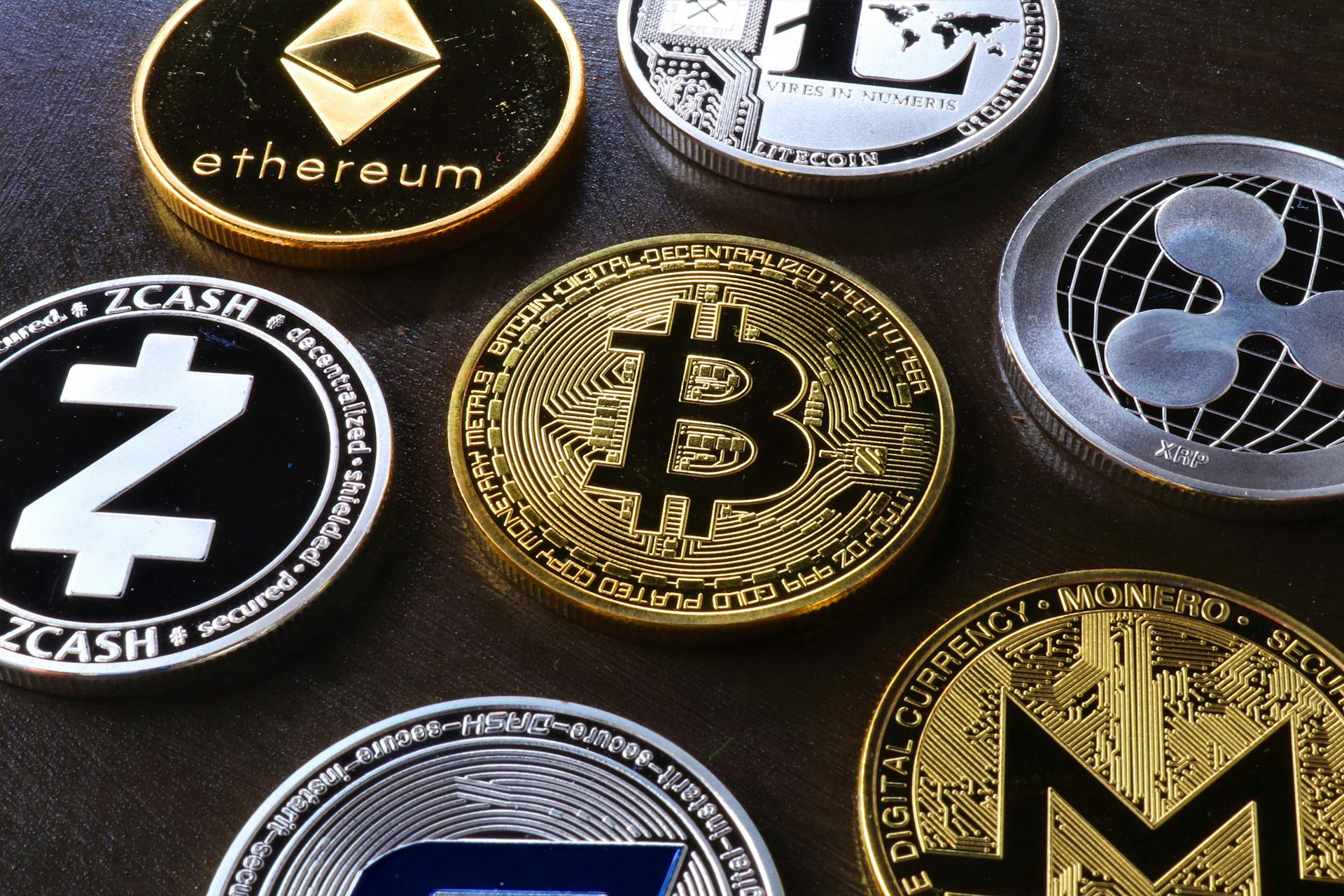
On January 8, 2009, the first version of the Bitcoin software was announced to the Cryptography Mailing List. This marked a significant milestone in the development of Bitcoin.
The first block was a crucial starting point for Bitcoin mining, which officially began with the mining of Block 1 on January 9, 2009.
Broaden your view: How to Invest in Bitcoin Mining
Regulating
Regulating Bitcoin is a complex and ongoing process. As of December 2024, the U.S. administration is seeking to impose regulations on cryptocurrency, but is also trying not to throttle a growing and economically beneficial industry.
Existing securities, commodities, and tax laws are being relied on by enforcement agencies in the U.S. However, no attempts from legislators have gained much attention from the country's law-making bodies.
The European Commission's Markets in Crypto Assets legislation came into force in 2023, setting the stage for cryptocurrency regulations in the European Union. This legislation is a significant step forward in regulating Bitcoin and other cryptocurrencies.

India has taken a different approach, banning several exchanges in December 2023 and continuing to push back reviews of any legislation regarding Bitcoin and other cryptocurrencies. This highlights the varying approaches to regulating Bitcoin around the world.
Here are some of the regulatory risks associated with Bitcoin investing:
- Regulatory risk: The continuous battle between cryptocurrency-related projects and regulators makes longevity and liquidity an unknown.
- No guaranteed value: Bitcoin is not considered a security by the authorities, but that stance could change in the future.
Storing Purchases
You can store your Bitcoin in a digital wallet, specifically a hot wallet or a cold wallet. A hot wallet is generally faster, but a cold wallet is much more secure.
Cold wallets are small, encrypted portable devices that allow you to download and carry your Bitcoin. They can cost less than $100.
To keep your digital wallets and currency exchange secure, use a strong password and two-factor authentication when creating accounts. This is a good practice to follow to protect your assets.
Related reading: Hot Crypto Coins
Six Investment Strategies
You can buy Bitcoin directly on a crypto exchange, such as Binance.US, Coinbase, or Kraken, and create a "crypto wallet" to hold your fractional shares.
Investing in Bitcoin can be done through online stockbrokers like Fidelity and E-Trade, or trading apps like Robinhood, where you can buy a fraction of Bitcoin for as little as $1.
Exchange-traded funds (ETFs) are another way to invest in Bitcoin, approved by the SEC earlier this year, and can be bought from investment firms like Blackrock and Fidelity.
Bitcoin can be traded as fractional shares, so your investment could be as low as $25, making it accessible to a wider range of investors.
If you're new to investing in Bitcoin, consider dollar-cost averaging, where you invest a set amount of money at regular intervals, regardless of the price.
To invest in Bitcoin, you can also use money transfer apps, Bitcoin ATMs, or traditional brokers that offer cryptocurrency trading.
Here are the six most common ways to invest in Bitcoin:
- Bitcoin wallets and centralized cryptocurrency exchanges
- Certain traditional brokers
- Money transfer apps
- Bitcoin ATMs
- Bitcoin ETFs
- Online stockbrokers and trading apps
Exchanges and ETFs
To invest in Bitcoin, you can purchase it from cryptocurrency exchanges, such as Gemini, Kraken, Coinbase, and Crypto.com, which offer a variety of fees and consumer protections.
You can also invest in Bitcoin through exchange-traded funds (ETFs), which are a type of investment fund that tracks the price of Bitcoin. The Securities and Exchange Commission (SEC) has approved spot Bitcoin ETFs, which track the price of Bitcoin and trade over major exchanges.
Some popular Bitcoin ETFs include the Amplify Transformational Data Sharing ETF (BLOK), the First Trust Indxx Innovative Transaction & Process ETF (LEGR), and the Fidelity Crypto Industry and Digital Payments ETF (FDIG). These ETFs have different investment strategies and fees, so it's essential to do your research before choosing one.
Here are some key stats for these ETFs:
Remember to always do your own research and consider your investment goals and risk tolerance before investing in Bitcoin or any other investment.
Cryptocurrency Exchanges
You can purchase bitcoin from cryptocurrency exchanges, which offer a range of options and fees.
Many exchanges carry dozens of cryptocurrency choices, while others may only offer Bitcoin and a few alternatives.
Gemini, Kraken, Coinbase, and Crypto.com are examples of cryptocurrency exchanges where you can purchase bitcoin.
Some exchanges have different consumer protections, so it's essential to do your due diligence before choosing one.
These exchanges have varying fees, so be sure to compare them before making a decision.
Expand your knowledge: Bitcoin Exchanges
Exchange-Traded Funds
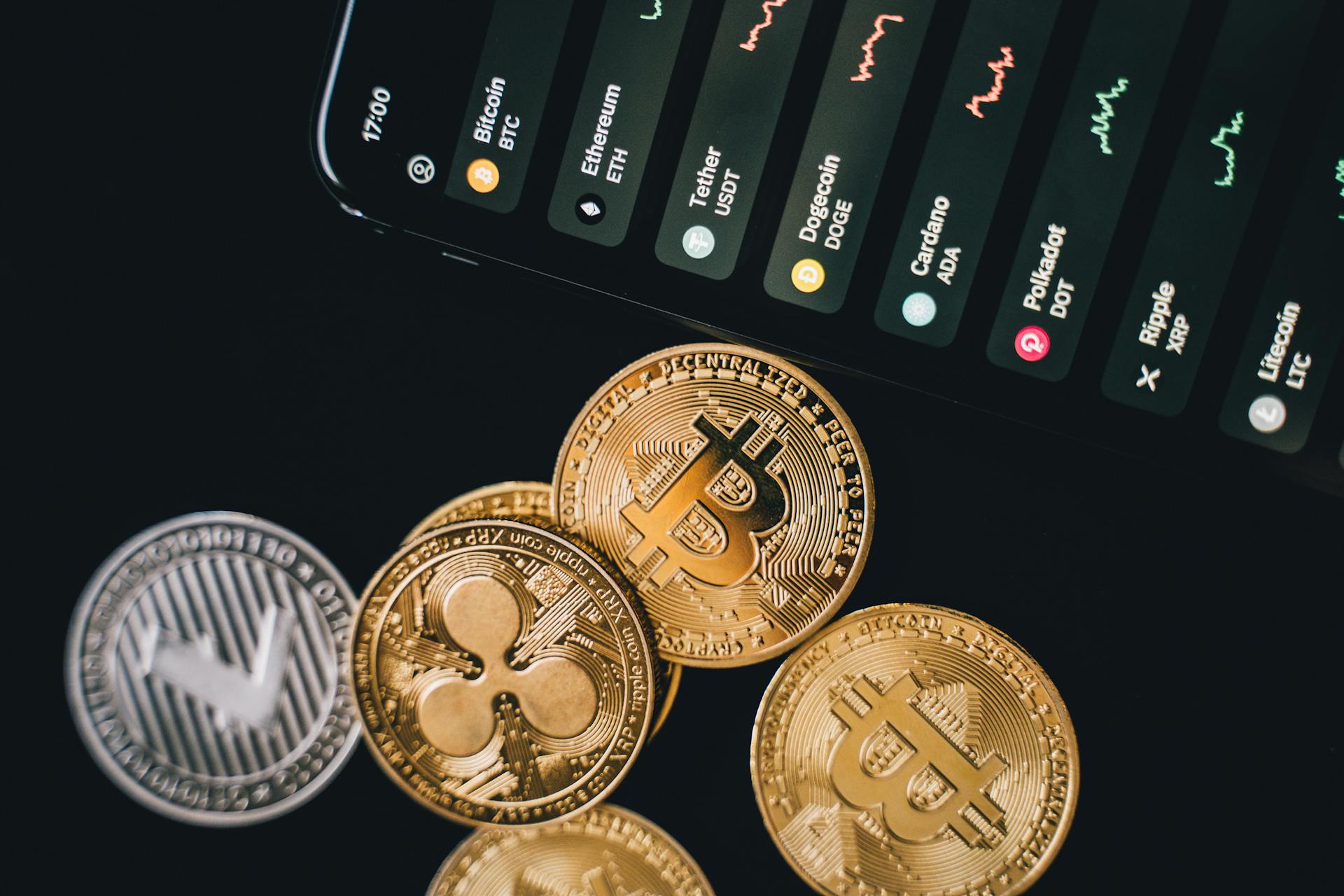
Exchange-Traded Funds (ETFs) have become a popular way for investors to gain exposure to the cryptocurrency market. These funds track the performance of a particular index, sector, or asset class, allowing investors to diversify their portfolios and gain exposure to the growing digital assets space.
The First Trust Indxx Innovative Transaction & Process ETF (LEGR) is an equity-based cryptocurrency ETF that tracks the performance of the Indxx Blockchain Index. This index follows companies connected to blockchain technologies, eliminating stocks with market caps of less than $250 million and three-month average daily trading of less than $1 million.
One of the benefits of ETFs is that they provide a convenient and cost-effective way to invest in a particular asset class or sector. The Fidelity Crypto Industry and Digital Payments ETF (FDIG) is a relatively new crypto ETF that seeks to track the performance of the Fidelity Crypto Industry and Digital Payments Index.
A different take: Why to Invest in Index Funds
The VanEck Digital Transformation ETF (DAPP) is a passively managed fund that tracks the performance of the MVIS Global Digital Assets Equity Index. This index includes companies that participate in the digital assets economy, such as MicroStrategy and Coinbase Global.
The Bitwise 10 Crypto Index Fund (BITW) is an open-ended, publicly traded statutory trust that tracks the performance of the Bitwise 10 Large Cap Crypto Index. This index represents the 10 largest investable cryptocurrencies, with bitcoin accounting for 74% of the portfolio.
Here are some key statistics on the ETFs mentioned:
The Amplify Transformational Data Sharing ETF (BLOK) is an actively managed fund that aims to invest at least 80% of its assets in companies that are involved in developing blockchain technologies and using them for their own business. This ETF has 52 holdings, with the top 10 accounting for about 38% of its assets.
Frequently Asked Questions
Can I invest in Bitcoin with $100?
Yes, you can invest in Bitcoin with $100, as it's enough to buy a small fraction of Bitcoin, currently 0.00103 BTC. With a $100 investment, you can start exploring the potential of Bitcoin's future growth.
What if I bought $1 dollar of Bitcoin 10 years ago?
If you invested $1 in Bitcoin 10 years ago, it would be worth approximately $277.66 today, representing a staggering 26,967% return on investment. This remarkable growth highlights the incredible potential of Bitcoin as a lucrative investment opportunity.
Sources
- https://www.ishares.com/us/strategies/ways-to-invest-in-bitcoin
- https://www.investopedia.com/terms/b/bitcoin.asp
- https://www.usatoday.com/story/money/2024/12/05/bitcoin-100k-cryptocurrency-investment/76797676007/
- https://www.nerdwallet.com/article/investing/how-to-invest-in-bitcoin
- https://www.kiplinger.com/investing/cryptocurrency/603600/bitcoin-etfs-cryptocurrency-funds
Featured Images: pexels.com
